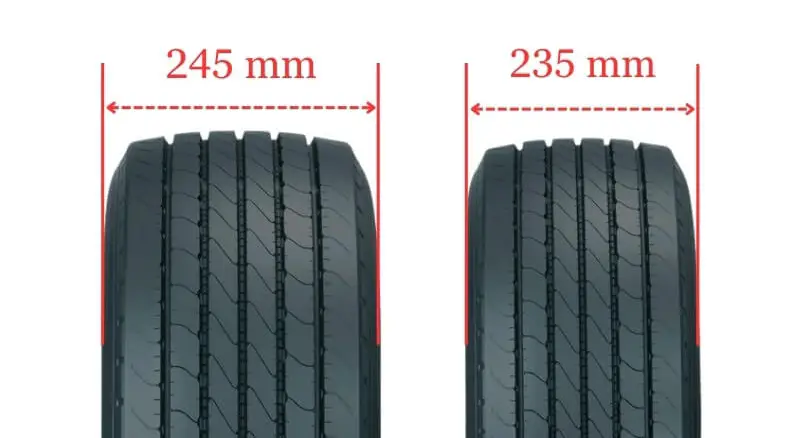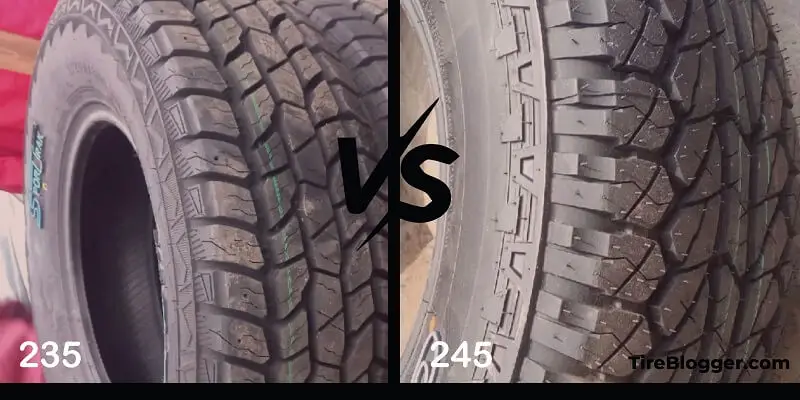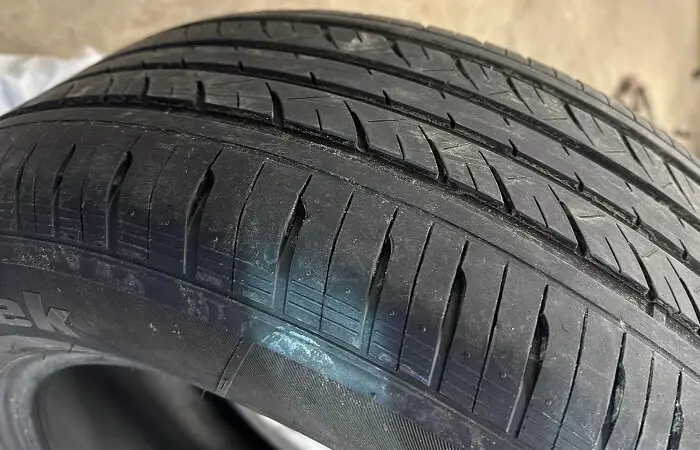245 vs 235 Tires

The main difference between a tire size 245 and 235 lies in the tread width, with the 245 having a width of 245 millimeters and the 235 having a width of 235 millimeters.
That means the 245 tire is 10 mm wider than the 235 tire. This 10-millimeter difference affects various performance factors, although the variation between these similar tire sizes is relatively minor.
235 vs 245 Tires
This table makes it easy to compare tire sizes and understand their differences.
| Tire Size 235 | Tire Size 245 |
|---|---|
| Narrower 9.25 inch tread width | Wider 9.65 inch tread width |
| More responsive handling | More stable handling |
| Slightly better fuel efficiency | Slightly more traction |
| Quieter ride with less noise | Absorbs bumps and vibrations better |
| Aesthetically sleeker profile | Aggressive, robust aesthetic |
| Can cut through snow/ice better | Added traction in mud or dirt |
| Even tread wear, longer life | Handles impacts well, durable |
| Skinnier look promotes aerodynamics | Offers more ground clearance |
Ground Clearance
A wider 245 tire provides slightly more ground clearance than a 235, which can be beneficial for off-roading or clearing obstacles.
However, this difference of just under half an inch is quite tiny and may not make a significant impact on ground clearance in most conditions. Both tires should provide adequate clearance for daily driving.

Gas Mileage
With a marginally smaller contact patch, the 235 tire offers somewhat improved fuel efficiency over the 245.
However, the effect on gas mileage is minimal with just a 10-millimeter difference in tread width. For most drivers, either tire size will deliver comparable fuel economy during daily use.
Ride Comfort
The 245 slightly larger air volume and sidewall flex can dampen vibrations better than the 235, providing more ride comfort, especially over uneven surfaces.
However, both tire sizes deliver reasonably comfortable daily driving and highway-use rides.
Aesthetics Look
Some drivers may prefer the visual appeal of the wider 245 tires, conveying a more aggressive stance. In contrast, others may favor the 235 slender profile that promotes aerodynamic efficiency.
Overall aesthetics are a matter of personal taste, with little major visual difference between the two sizes.

Handling & Stability
The 235 tire offers marginally quicker steering response and handling from its narrower tread. However, the wider 245 promotes stability and traction through turns and uneven conditions.
For most routine driving scenarios, both tires deliver reliable handling and stability.
Noise & Vibration
With a narrower tread, the 235 produces slightly less road noise, transmits fewer vibrations, and promotes a quieter ride than the 245.
However, the difference is subtle, and both tires dampen noise and vibration effectively for daily commuting.
Durability & Wear
The 235 smaller contact patch distributes wear more evenly, potentially increasing tread life slightly over the 245.
However, both tire sizes exhibit good durability and tread wear when properly maintained. Expected tread life is comparable between the two.

Adverse Conditions
The 235 skinnier tread can sometimes grip the road better than the wider 245 in snow or rain. But the 245 provides more traction through deep mud or loose dirt. Overall, both perform well in adverse conditions, with only minor differences.
What Does 245 Mean On A Tire?
The number 245 on a tire typically refers to the tire’s width in millimeters. In tire size designation, the first three digits represent the tire’s width when mounted and inflated to the recommended pressure.
Therefore, a tire marked as 245 means the tire is 245 millimeters wide.
What Does 235 Mean On A Tire?
The 235 on a tire refers to its width in millimeters. So, a tire marked 235 is 235 millimeters wide from sidewall to sidewall.
This width measurement specifically refers to the width of the inflated part of the tire and does not include the protruding sidewall shoulder rubber.
How Much Taller Is A 245 Tire Than A 235?
Assuming the aspect ratio of 40, a 245 tire would have a sidewall height of 245 x 0.4 = 98mm. Similarly, a 235 tire at an aspect ratio of 40 would have a sidewall height of 235 x 0.4 = 94mm.
With two sidewalls per tire, the total height difference between a 245 tire and a 235 tire is 2 x (98mm – 94mm) = 8mm.
So, with equal 40 aspect ratios, a 245 tire is about 8 millimeters taller overall compared to a 235 tire of the same aspect ratio. The difference is slight but can be significant for tight clearances.

How Much wider Is A 245 Tire Than A 235?
As the numbers on tires indicate their width in millimeters, the difference in width between them is simply the difference between the numbers. A tire marked 245 is 245 millimeters wide, while a 235 tire is 235 millimeters wide.
Subtracting the smaller width from the larger gives the width difference: 245mm – 235mm = 10mm. Therefore, a 245 tire is 10 millimeters wider than a 235 tire.
Are 235 And 245 Tires Interchangeable?
To ensure tire interchangeability, the overall diameter difference should not exceed 3%. To calculate the overall diameter, you need to know the aspect ratio and rim size of the tire.
Let’s say you have two tires with the same aspect ratio of 40 and mounted on a 19-inch rim size. In this case, you can replace a 235 tire with a 245 tire.
The difference in diameter between the two tire sizes is 1.2%, within the generally accepted range for tire replacements. As long as the 245 tires have a load capacity that matches or exceeds that of the original 235 tires, it should be a suitable replacement.
Our Observation
After comparing the nuances between these two similar tire sizes, I’m struck by how minor the differences truly are. While the 245 is slightly wider, conferring some advantages in stability, traction, and absorbing irregularities in the road, its performance aligns closely with the narrower 235 across key areas.
I don’t see strong reasons to choose one width over the other for most daily drivers who value responsive steering, even tread wear and fuel efficiency. Unless you frequently go off-road where the 245 extra traction shines.
Either tire should suit your needs and provide a smooth, quiet ride. Ultimately, personal preference in looks may matter more than performance in deciding between these two great options.

Meet Caitlin McCormack, a Tire Size Expert and Blogger Passionate About Everything Related to Tires. With Years of Experience in the Tire Industry, Caitlin Has Become an Expert in Tire Sizes and Their Impact on Vehicle Performance.
